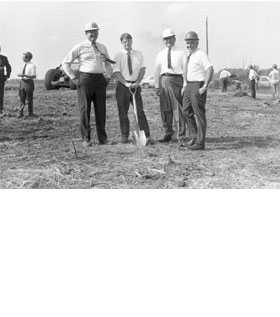NAL Starts Work on Main Ring Enclosure
An informal ground-breaking to mark the start of construction of the Main Accelerator - the largest single component in the NAL accelerator system - was held under sunny skies on the NAL site at 11:30 a.m. Friday, October 3, 1969.
Robert R. Wilson, NAL's director, turned the traditional first shovel of earth for excavation to begin on the Main Accelerator Enclosure as members of the Main Ring staff and employees of D U S A F and sub-contractors watched.
The earth was firm and the atmosphere bright as the formal start of work began on the main accelerator enclosure for the world's largest scientific instrument - the 200 Billion Electron Volt proton synchrotron. The Main Accelerator enclosure will cover an area approximately four miles in circumference and 1.24 miles in diameter on the 6,800acre NAL grounds.
Actually, work had begun on the excavations for the Main Ring enclosure about 10 days before to take advantage of the Autumn weather's favorable atmosphere for construction workers.
Award Contract
A $3,428,917 contract had been awarded several weeks before by DUSAF to Schless-Madden Co., Inc., of Batavia, for Phase One of the Main Accelerator. It covers one-sixth of the Main Accelerator work.
Among others who took part in the ground-breaking were Parke Rohrer, DUSAF's project manager for NAL; Robert Schless and Thomas Madden, the sub-contractors, and Thomas Collins, Associate Director of NAL.
Work also is in progress on the Main Ring road and it is estimated that the entire Main Ring job, as of September 30, was three per cent completed - or, on schedule.
Start Main Ring Prototype
Meantime, members of the Main Accelerator staff working in the NAL village are developing prototypes of components for the Main Ring. The first 20-foot B-2 bending magnet has been completed in the NAL Laboratory. Valuable information has been obtained on coil tolerances in assembly, on assembly techniques, and on the mechanical behavior of the complete structure. This magnet will be used in testing of measuring systems and testing of the magnet installation vehicle.
A new and simplified method of fabricating bending-magnet coils, suggested by Robert Sheldon, is being tested. The coil for each magnet will be built as three separate coils, a 4-turn inner coil close to the beam where accurate tolerance must be maintained, and two outer "window" coil that can be built to standard commercial tolerances. All three coils will have saddle ends, rather than the previous T ends.
B1 Magnet Re-Designed
In the new design, the B2 magnets will have slightly altered dimensions. In the B-1 Magnet, it has been found that significant cost saving can be achieved by changing from a 24-turn to a 12turn coil. Magnetic redesign of the B1 magnet for this change is almost complete.
NAL has rented a building in West Chicago, north of the site, in which to produce inner coils.
Ernest Malamud has been appointed co-ordinator of a task team on controls to supervise the design of the control systems for the individual accelerators and for the accelerator or facility as a whole.
Linac Enclosure 75% Done
Meantime, work continues somewhat ahead of schedule on the Linear Accelerator Enclosure structure on which the first NAL groundbreaking was held last December 1. The walls and roof of the equipment gallery are almost complete. It is estimated that the effort is about 75 per cent finished.
On the Booster enclosure, the underground-enclosure structural work has been completed over most of the circumference and earth backfill placed. Work has begun on the linac extension and on electrical utilities in the enclosure. The Booster building is about 40 per cent completed and is on schedule.
Structural erection is underway on the Cross Gallery, with the work about 15 per cent completed.
In Radiation Physics, the first phase on the experiments to measure soil activation by strongly interacting high-energy particles has been underway. The preliminary results appear to show that there will be no special problems with contamination of underground water under the extraction straight section in the Transfer Hall.
Task Forces Started
Experimental Facilities: Task forces have been organized within the section to work in detail on various aspects of experimental utilization. There are task forces on Experimental Areas 1 and 2, on secondary-beam design, shielding, magnets, beam systems, detectors, and on spectrometer systems. These groups will start from the 1968 and 1969 Summer Study reports and develop firm plans in their areas of responsibility. A series of regular meetings is planned with physicists from other institutions to review and develop further the work of these task forces.
Notices to proceed have been issued on Phase II of the Cross Gallery for $678,428 and on Phase II of the Utility Plant for $760,000 and the Enclosure Piping ($137,000) in the Booster and Utility Plant areas.
A Theoretical Physics Section has been established at NAL. Five physicists have joined the Laboratory staff as the first members of this new group. David Gordon is the acting head.
On September 30, the Laboratory had a total of 520 employees. Of these, 126 were engineers and scientists.


Photo by Tony Frelo, NAL. (2 of 2)


